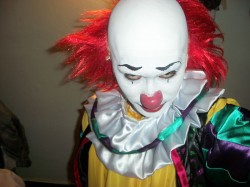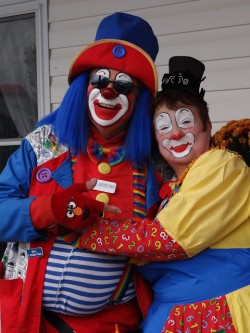On Facebook today I caught glimpse of a picture of circus clowns, circa 1920’s.
To me the image was beautiful but underneath the photograph were 20-some odd comments on the hatred and fear of clowns.
They wrote on how creepy they are, how Stephen King ruined their love of “Bozo” with his book, IT. I’m sure the notorious, real life “Killer Clown” serial killer and rapist, John Wayne Gacy, adds to the fear of clowns, known as coulrophobia. The fear of clowns is very real for many people, but there are also those like me who adore them.
When I moved in with my husband years back, his daughter walked past my clown thinking no one was watching, and kicked it. It was funny to see, but it also saddened me to see her at a tender three-years-old and already ridden with a hatred of clowns.
As a child I collected them. I went to clown school to learn how to be one, how to apply make-up, develop a clown identity, and I even shed a tear when the great Red Skelton passed away in 1997. Red Skelton began as a circus clown in his teens before appearing on Broadway, in vaudeville, in films, and grew to having his own show, The Red Skelton Show.
I loved staring at my numerous paintings, with their velvety backdrops; the bright colors seemed to dance off the painting right into my clown-loving heart. My bedroom was covered with them, and often when friends or family members came into my room, they were a little freaked out by all the masked faces looking back at them.
There is sometimes a sadness surrounding clowns.
The hobo clown, a traveling kind with the painted sad face, is one of my personal favorites—he is always down on his luck but still maintains a positive attitude. He is nothing to fear, but rather admire, if not only for his optimistic outlook in the midst of despair.
Clowns are people who mask their faces to bring happiness to others with their water squirting flowers, colorful wigs, ruffled collars and oversized shoes. They posses a skill set that enables them to work dangerously at rodeos, distracting bulls and saving the lives of cowboys in that bone crushing sport.
The skills needed to perform safe trickery while performing comedic acts requires in-depth training—it deserves our gratitude and respect rather than ongoing disdain.
The first clown to have been found was around 2400 BC, when the role of priests and clowns were played by the same person, truly where religion and magic intersect.
 Surely there are more good clowns—that offer joy, light heartedness, and positive entertainment—than “bad clowns,” such as Stephen King’s “Pennywise” and the real life “Killer Clown.”
Surely there are more good clowns—that offer joy, light heartedness, and positive entertainment—than “bad clowns,” such as Stephen King’s “Pennywise” and the real life “Killer Clown.”
Reclaiming the joy of clowns and lifting them from the negative light they’ve been relegated to for so long is a hugely compassionate act. It’s also an opportunity to make a conscious choice toward shifting our perspective from a negative way of seeing into a more positive one, which ironically is at the heart of the clown’s purpose.
As a child I wanted to be a clown more than anything. I attended school to aspire to work as one, but found that the life of a clown, in a culture where they are so greatly feared, loathed and hated by so many is no easy identity to assume. Imagine walking into a room hoping to share joy with others and have people either run from you or cringe at your presence. I deeply admire those that are able to put on the face and become a clown.
It’s not easy being a clown.
Spending time behind the make-up and costume helped me understand the feeling of being deeply disliked. My entrance into a room scared people and kids would run away. No matter how much I wanted them to like me, to make them laugh, there was just too much darkness surrounding how clowns are perceived for me to continue clowning.
I propose a more compassionate view of clowns.
I’m often an advocate for the underdog because being “other-ed” is at the heart of what it means to be an underdog. Clumping a group of people into a stereotypical view is a subtle, but violent act.
Clowns are continuously being prejudiced and shown in an evil light as being more scary than funny, when truly, if we take the time to look beyond the media’s view of them, past Stephen King’s “Pennywise,” we come to know a rich and important history of clowning.
Clowns represent a vital aspect of what it means to be a healthy human:
They remind us not to take ourselves too seriously, to laugh at ourselves, to learn from our mistakes with a greater sense of joy rather than clinging to harsh views. They also remind us of the many masks we wear in the world, and the choice we have to put forward the best and most vulnerably authentic faces we can muster—and how that takes courage.
They teach us that it’s okay to be different, to be unique, to have big feet and to have fun during the mundane. They show us how to get back up after we’ve fallen down and to keep dancing.
“But where are the clowns. There ought to be clowns. Quick, send in the clowns,” because clowns are great teachers.
There’s magic to be found when we look at the world through the eyes of a clown.
Love elephant and want to go steady?
Sign up for our (curated) daily and weekly newsletters!
Editor: Catherine Monkman
Photos: Wikimedia Commons, Manuel Angelini/Pixoto, Vivian Gordon/Pixoto













Read 2 comments and reply